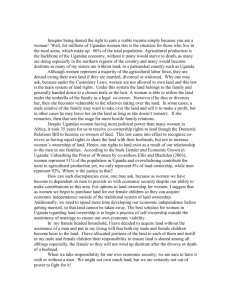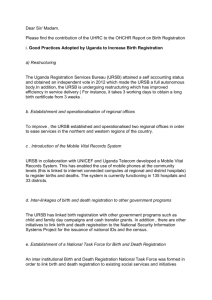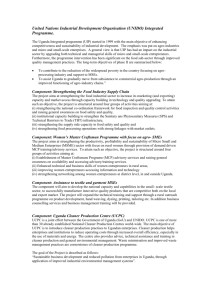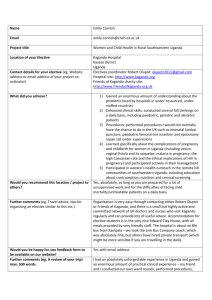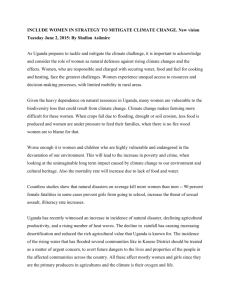Gender and Entrepreneurship
advertisement
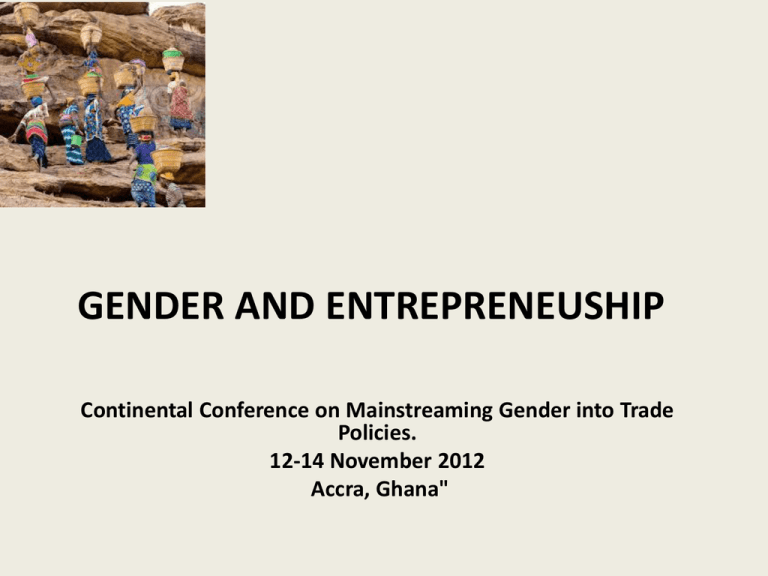
GENDER AND ENTREPRENEUSHIP Continental Conference on Mainstreaming Gender into Trade Policies. 12-14 November 2012 Accra, Ghana" Introduction • The micro and small-scale enterprise sector plays an important role in African countries. • The sector makes a significant contribution to the gross domestic product in Liberia -34.6%, Nigeria - 24.5%, Kenya 19.5%, Benin - 17.7% and Uganda - 20%. • Based on the 2011 labour force figure of 11.5 million, (UBOS, 2011), the number of persons employed in informal sector was estimated to be 2,2 million. • Its significance is underpinned by the fact that it: • Contributes 60% of the population’s total household income. • Provides additional income to most people in formal employment and agriculture. • Is easy to enter and exit. • Provides a good entry point for women and other disadvantaged groups into commerce • In the 1999/2000 Uganda National Household Survey, 74.8% of Uganda’s 26.4 million people were engaged in economic activity - 38.7% of these were women. • Minnitti, et al (2004), confirms that in many countries, men are more active in entrepreneurship than women. In developing countries like Uganda, 41% of men are more likely than women to be active entrepreneurs. MSEs and Women in Uganda • Women enterprises are mainly concentrated in the informal sector and they constitute 45% of the MSEs. • The majority - 92% - of business establishments in Uganda are sole proprietorships and 39% of these are owned by women (UBOS, 2003). • Less than 20% of private limited companies have women owners; only 2.1% of women owners are involved in this form of business ownership. The impact of gender on all key activities needs to be given careful consideration • Women are more likely, (because of lack of information and exposure), to get into businesses that are already well served. • Local businesses serve local markets there tends to be little room for expansion or growth, thus these enterprises are more often than not destined to remain small A Comparative Analysis of Men and Women Entrepreneurs • Business Structure - flatter management structures, • Decision making - Use consensus building approaches and value performance results differently. • De facto social entrepreneurs –finance the social support services that they deliver Constraints Experienced By Women Entrepreneurs • SMEs experience many constraints but for women it is aggravated by the gender-based obstacles. a) Administrative constraints • Women find it difficult institutional markets to access • The lengthy procedure of expression of interest, acquiring bid documents (Ushs 30,000 - Ushs 100,000) • Local council system of settling commercial disputes is plagued by traditional attitudes and the use of customary laws which all too often militate against women. b) Financial constraints • High interest rates and exploitative loan payment conditions from microfinance institutions b) Technological constraints – Lack the adequate technical capability, skills and knowledge in varying trades which can result in the production of poor quality products – Products are not standardised d) Information and market constraints • Women are not as readily exposed to the information and knowledge that men are. • Men have more free time and as a consequence are free to do more networking. • Lack of representation of women in key decisionmaking organs within the private sector; 700 members of UMA, (350 are active) only 22 of those active members are women. 2 positions for women on their Executive Board of 18 members. WOMEN’S GENDER ROLES AND ENTREPRENEURSHIP • The seven gender roles Oppong and Abu (1985); – Parental role behavior – Occupational role behavior – Conjugal behavior – Domestic role behavior – Individual rile behavior – Community role behavior – Kin role behavior The roles are too many; • Constraint women’s participation and performances in economic activities. • Burdensome • Time-consuming • Unpaid for • Gender roles suppress entrepreneurial behavior of women except for occupational, individual and community which exposes women thus developing their entrepreneurial competencies Conclusion • Women have the additional burden of family and domestic responsibilities. This has the side-effect of encroaching on their capacity to generate income. The Poverty Eradication Plan, (PEAP 2005), notes that there is a persistent pattern, i.e. that ‘poverty has a female face’. • Gender and entrepreneurship are interlinked and cannot be ignored if women are to be supported in business Thank you for listening



